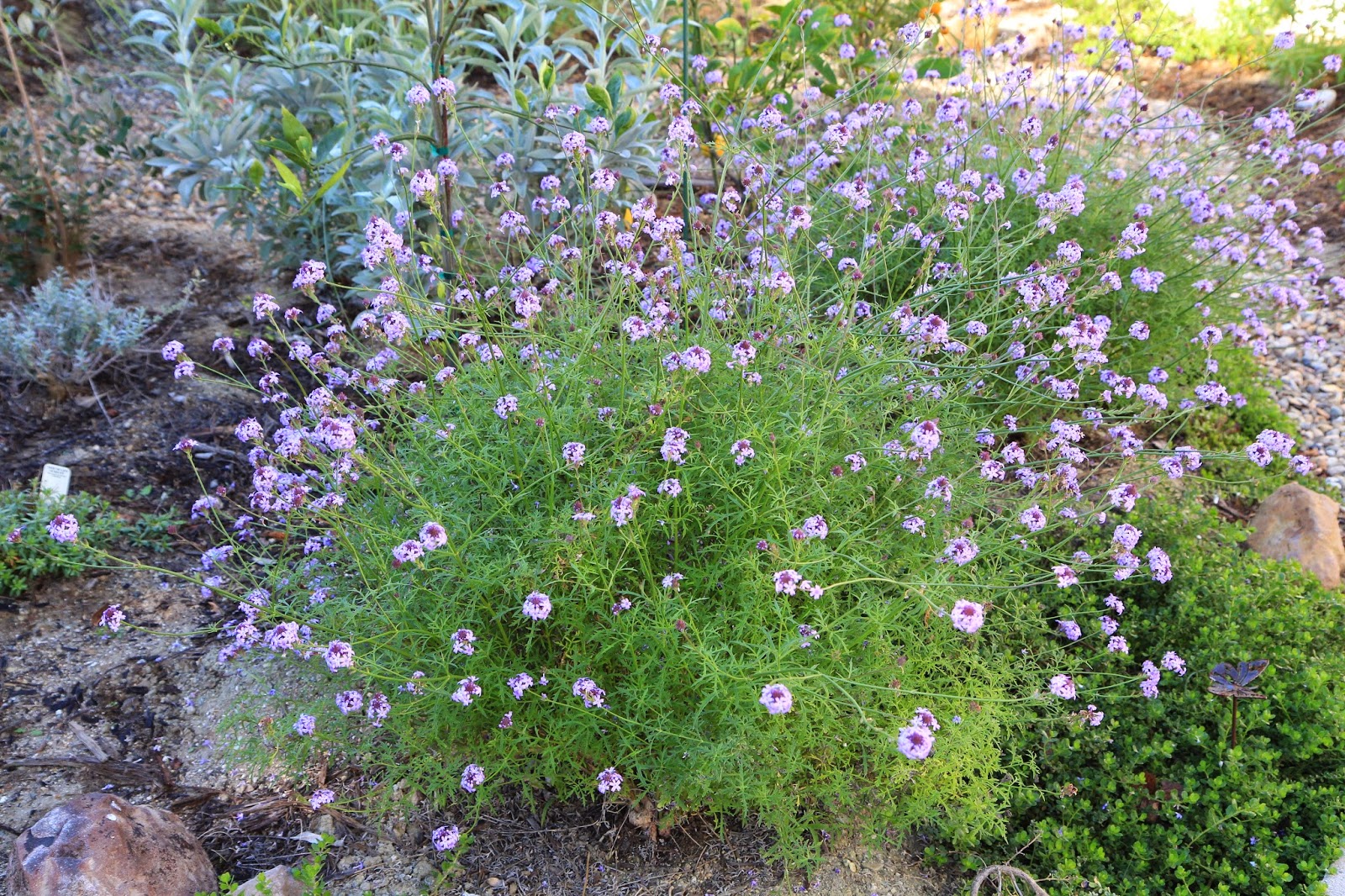Lilac Verbena, one of my longest bloomers, is native to Baja California. Its cousin Western Vervain (Verbena lasiostachys) is found all around CA and has a long blooming season but isn't much to look at. LV used to be called Verbena lilacina, but in 1979, Umber renamed it Glandularia lilacina. Not everyone got the memo. So much for Latin names clarifying things.
Hummingbirds, bees, and butterflies love it. Its flower stalks are long-lasting, though they can get a little shaggy toward the end of their lives. It starts with a bang in late January, and will bloom through June or beyond. (This year with the heat, maybe not.) Lilac Verbena has a subtle but pleasant perfume, spicy with a hint of cloves. (In my garden, it is swamped out by the sages.)
LV branches are brittle. If you keep most of the plant as you bring it home from the nursery and plant it, you are doing well. If you break it, don't feel bad. It will grow back fast. I planted my first LV on top of a mound. In the first Santa Ana windstorm, I lost 2/3 of the plant. I dug it up and placed it a bit downslope, and it has been happy ever since.
Among its other stellar qualities, LV is said to be deer and rabbit-proof. It blooms well with a half-day or less of sun. It is said to tolerate garden water. But it can do with little summer water. Reports vary on its frost-hardiness. 20 degrees? If it looks dead, don't despair. It may grow back. It is grown from seed. I have seen small sprouts under the parent, but it is not a prolific reseeder.
LV dies back in summer, at least with proper (i.e. little) watering. You can trim and thin it pretty extremely as it turns brown. If you don't, it will look shabby up close. Starting with the first Fall or Winter rains, it will start growing, seemingly expanding daily. In year three, almost all of my LV's are still going strong, and I keep planting more. (One planted in late spring in clay did not prosper and was removed.)
The cultivar 'de la Miña' is most widely available. Carol Bornstein, then Director of Horticulture at the Santa Barbara Botanic Garden, collected it from Cañon de la Mina on Cedros Island. 'De la Miña' is a remarkably symmetric cultivar, a spherical green bush sporting a halo of long-stemmed lilac flowers. It would do credit to the most formal garden, and wants a bit of space around it to show off its symmetry.
The species, presumably from the mainland, is harder to find, but Tree of Life Nursery usually has it. It blooms just as long. Its foliage is more rambling, and it can get pretty gawky if you don't trim it, but with a little pinching back, it looks tidy enough. It rambles well around, through, and over a bed of coastal sage scrub-type plants. I am mixing it with CA Fuchsia (which also is good at filling in the cracks) for the longest blooming season.
Some facts about LV from Theodore Payne Foundation can be found here.
Lilac Verbena is a reliable and long blooming native perennial. If you plant one now, it will give you a show this spring. Give it a try!
 |
| A flock (?) of these beauties came by one day and sipped on the Lilac Verbenas all afternoon. |
 |
| I know Lilac Verbena is rugged because it's surviving in our neighborhood common area (with Matilija Poppies.) |
Among its other stellar qualities, LV is said to be deer and rabbit-proof. It blooms well with a half-day or less of sun. It is said to tolerate garden water. But it can do with little summer water. Reports vary on its frost-hardiness. 20 degrees? If it looks dead, don't despair. It may grow back. It is grown from seed. I have seen small sprouts under the parent, but it is not a prolific reseeder.
LV dies back in summer, at least with proper (i.e. little) watering. You can trim and thin it pretty extremely as it turns brown. If you don't, it will look shabby up close. Starting with the first Fall or Winter rains, it will start growing, seemingly expanding daily. In year three, almost all of my LV's are still going strong, and I keep planting more. (One planted in late spring in clay did not prosper and was removed.)
 |
| Cultivar 'de la Miña' looking so symmetrical |
 |
| With a little pinching, the species can look gorgeous alongside other natives. It does not hold its flowers so high. Can you see the butterfly and the lizard? |
Some facts about LV from Theodore Payne Foundation can be found here.
Lilac Verbena is a reliable and long blooming native perennial. If you plant one now, it will give you a show this spring. Give it a try!
To subscribe to this blog,
click here.
To use text or photos from this blog, click here. To share this post (do share!) click on the appropriate tiny icon below (email, facebook, etc.)
To use text or photos from this blog, click here. To share this post (do share!) click on the appropriate tiny icon below (email, facebook, etc.)






No comments:
Post a Comment